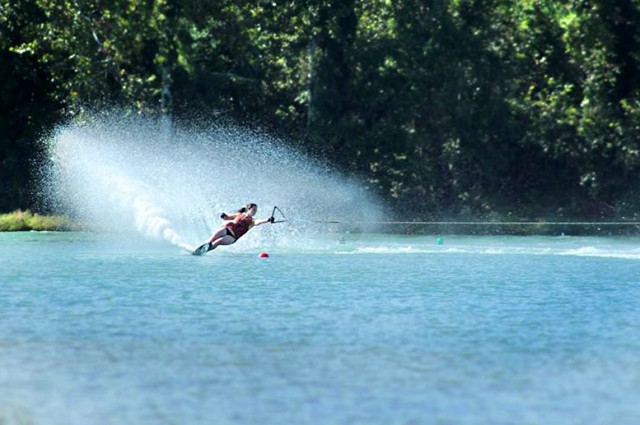Water Skiing Draws Athletes Looking for Less Painful Thrills

UT senior Hannah Fielding competes in the 2014 national water ski championships in Zachary, Louisiana. Photo courtesy of UT Water Ski
By Jori Epstein
For Reporting Texas
Struggling to keep her balance atop her water skis, Alli Marbach leaps into the air, water spraying around her. In 20 seconds, she must execute elaborate, poised tricks—180- and 360-degree turns, jumps, flips and more. A lifelong dancer, Marbach is accustomed to maneuvering herself into unusual shapes and positions. But water skiing, she says, is different.
“There’s nothing to catch the water, so the ski is insanely slippery,” said Marbach, 22, a University of Texas business honors senior from Atlanta. “To keep your balance on it is the weirdest feeling at first. The water’s pushing you, and the boat is pulling you, so it’s a crazy mishmash of trying to keep your body together and your weight low without slipping off the skis.”
Marbach joined the University of Texas at Austin’s water skiing team partly because she grew tired of being injured as a dancer. The same is true of many of her teammates, who came to water skiing from other sports with higher injury rates like soccer, volleyball and even horseback riding.
“In cross-country and soccer, I fractured bones in my ankle and wrist,” said team captain Topher Jensen, a 21-year-old petroleum engineering major from Austin. “There’s less risk here than other sports because it’s on the water.”
Water skiing, with its airborne turns and jumps, looks dangerous, but the National Safety Council ranks it as safer than most sports, including volleyball, football and soccer. In 2009, less than 0.2 percent of water skiers had accidents that sent them to emergency rooms, according to the council. Five percent of football players ended up seeking emergency treatment. For soccer, the rate was 1.5 percent. The council doesn’t rank dancers, but according to a 2012 study in the Journal of Dance Medicine and Science, 82 percent of modern dancers end up injured.
“Water skiing usually is a solo sport and so is more predictable,” said Larry Abraham, a UT kinesiology and health education professor who specializes in biomechanics. “All of the land-based sports [with] greater risk include some collisions or impacts as an expected part of the game, and even more so in more competitive situations.”
Abraham says collegiate skiers still pay plenty of attention to safety measures, for liability reasons as well as injury prevention.
Nearly all skiing accidents come in jumping competitions. Jumpers ski as fast as possible to a ramp in hopes of landing the longest jump. Slalom and trick competitors—weaving through buoys and performing stunts—have little to worry about. An ambulance stands ready at all the club’s competitions.
The comfort she finds in water skiing contrasts with Marbach’s experiences as a dancer.
“Dance created stress, and water ski relieves all of my stress,” Marbach said. “You get out on the water and you calm down. It’s a very individual sport, but you combine as a team. There’s a lot more personal support for water ski since in dance, you’re competing against friends and we’d all hope the other one fell.”
As a dancer for 17 years, Marbach fell hard and often.
Between 25-hour dance weeks and regional and national competitions, she suffered a fractured foot, a torn ligament, broken ribs and a broken tailbone. The injuries, as well as chronic shin splints, started to pile up.
The water ski culture changed everything for Marbach. She translates her balance and mimicking skills from the dance floor to skis as she masters advanced tricks. Trick water skiing, Marbach said, lets her implement her dance skills in a safer, less stressful environment.
“I never got help for injuries in dance because I’d do it on the stage and had to keep dancing, or I’d be in a professional choreography and couldn’t sit out,” Marbach said. “When we’re injured in water skiing, we can get out and ice immediately. The safety precautions are way more prominent than they were in dance.”
Teammates recall stress fractures, broken necks and busted wrists in their previous sports, but they still accept that any sport has risks. The motto on their team T-shirts is, “If you didn’t fall, you didn’t try hard enough.”